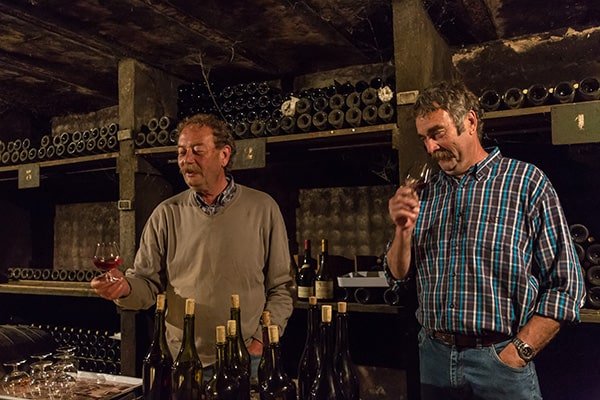Caves Jean Bourdy: The Familiar, Exotic Somethingness that is the Jura
Image credit: http://www.veritaswine.com/caves-jean-bourdy/
The Jura holds a special place for many. It is at once familiar and exotic — as though it has read the rule book, taken notes in the margins, and rewritten a translation. Traveling here, one feels the weight of history among the hills. It’s like a page from a Tolkien novel - mystical, haunted, and enchanting all at the same time.
The Jura has been growing vines since the 9th century thank to the Cistercian monks. They reside in the base of the Alps kissing Switzerland to its east, gazing at Burgundy to its west over the Saône. Their precarious borderland location took them down a path that only those who live on the knife edge of culture experience - a changing of hands over the centuries from the French to the Austrians to even the Spanish (perhaps Bastardo/Trousseau found its birth here at this point). Still, the Jura has had its hills and their unusual, fascinating Savignin-based vin jaune to fall back on for an identity.
Though they once farmed some of the most vines in all of France, this all changed at the turn of the 20th century when phylloxera, a couple world wars, and an attitude change regarding quality and terroir would see a decrease from nearly 20,000 hectares of vineyards to a mere 800 by the mid-twentieth century. Today, about 230 wineries harness nearly 200 vineyards that claim about 2,000 hectares in total, which represents about 0.3% of France’s planted vines… and you thought Burgundy was small (it’ about 85% larger!). The Jura wine region, known as the ‘Revermont’, runs about 80 km north to south between the Bressane plain to the west and the Alpine foothills to the east.
While the Jura resembles Burgundy in some ways — speaking to wine lovers with similar sensibilities for more nuanced, earthy, terroir-driven regional expressions — they are some important differences. The Jura’s soils are an extension of what one would find in Burgundy — but they are older. And that matters. At one point they were the same, and still are theoretically - with the youngest Jurassic marine-influenced limestone on top, the oldest clays as the base (Triassic). The Lias material between the two is a kind of unofficial term that bridges the two periods. However, tectonic activity divided the two regions, pushing the Jura and those older layers upward to form the Alps. Therefore, the higher plots in the Jura still see that same Jurassic limestone that characterizes Burgundy, but it predominantly experiences the older Triassic clays. As specialist Wink Lorch points out, where Burgundy’s base is limestone (80%) and marl to round it out, in the Jura this is the opposite. This Triassic influence arguably gives these wines the smoky, more rustic aromas according to Stephane Tissot.
And some wonder if its proximity and borderland situation makes it like Alsace, but the difference here is that one (Alsace) resides in a rain shadow, which we understand in the dry climate of Denver/Boulder. The Jura sips on the rain that builds up as it moves east towards the Alps. It receives nearly 50 inches a year! This is over twice what Alsace sees and a good quarter more than Burgundy or Bordeaux. Mildew and molds are a thing to manage even in the drier years. Still, about 15% of their vineyards are certified organic, which speaks to their collective ethos and makes them a leader in northern France along with Alsace.
Caves Jean Bourdy is one such leader, certified Demeter since 2006 and practicing in a more natural way with native yeast ferments, minimal intervention, very old barrels (as much as 80 years for some), and very restrained use of sulfur in winemaking. Their domaine has been making wine in the tiny hamlet of Arlay north of L’Etoile since 1495, making them one of the oldest continuing family wineries in the Jura (and the world for that matter). Today, the 15th generation brothers Jean-Francois and Jean-Phillipe are at the help overseeing the operations for 10 hectares. Jean-Francois would say that they make wine as they would have 200 years ago. In this way, we are given the rare opportunity to travel back in time with these wines.
They make a little bit of everything one might find from the Jura - from Cremant, whites, and reds, to Marc, Vin de Paille, and the revered Vin Jaune of Chateau Chalon. Here’s what we have coming:
Cremant du Jura- On average 20 year old vines, full malo, 16-18 months on lees, 10 g/l. 100% Chardonnay off red clay and gravel soils.
2018 Cote du Jura Chardonnay - On average 30 year old vines off 2.5 ha in Montausson Chaumal on clay, blue marl, and limestone at 230-250 meters facing south/southeast. Fermentation in inbox, aged 3 to 4 years in old oak barrels. No fining or filtering.
2018 Cote du Jura Savignin- On average 35 year old vines off 2.5 ha in Montausson Chaumal on clay, blue marl, and limestone at 230-250 meters facing south/southeast. Fermentation in inbox, aged 3 to 4 years in old oak barrels. No fining or filtering.
2020 Cote du Jura Rouge - On average 35 year old vines off 3.2 ha in Monfied Pierrefay on red clay and gravel at 230-250 meters facing south/southeast. Whole cluster press and fermented in old oak barrels - aged for 4 years. No fining or filtering.
